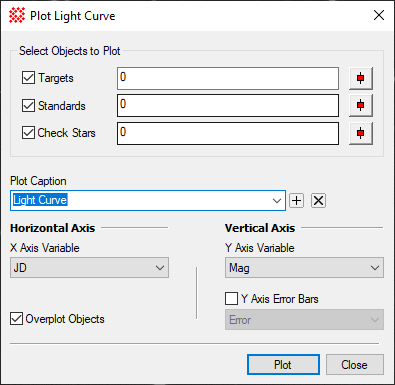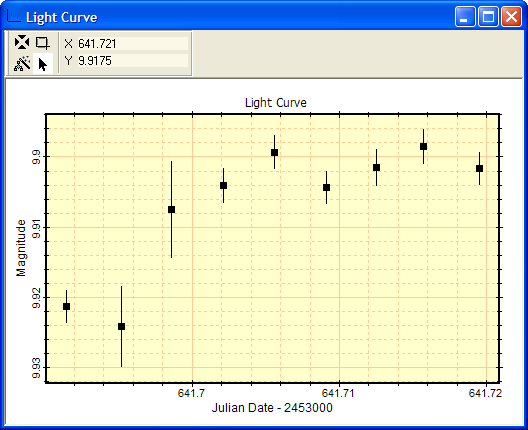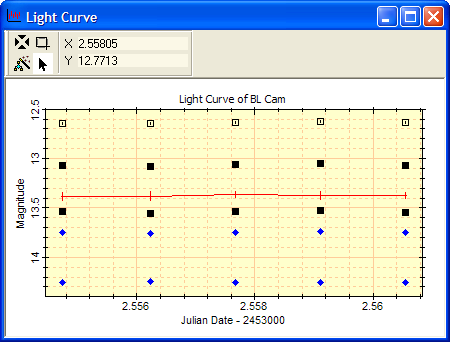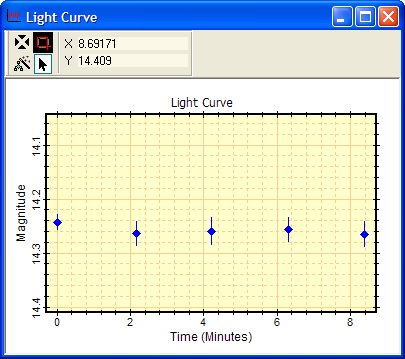The Plot Light Curve command opens from
the ![]() button on the Aperture Photometry
Toolbar. On the dialog, click Plot to
generate the light curve.
button on the Aperture Photometry
Toolbar. On the dialog, click Plot to
generate the light curve.
Plot Light Curve
When an image set is measured using the Aperture Photometry package, Mira can automatically generate a light curve showing the variation in magnitude versus time for selected target objects, standard stars, and check stars.
The Plot Light Curve command opens from
the ![]() button on the Aperture Photometry
Toolbar. On the dialog, click Plot to
generate the light curve.
button on the Aperture Photometry
Toolbar. On the dialog, click Plot to
generate the light curve.

Values plotted are taken from data in the Apphot Pane. Column titles from the photometry table are used for the X Axis Variable, Y Axis Variable, and Y Axis Error Bar. In this example, a Julian Date offset was set in the Photometry Properties dialog, and that value is shown in the X Axis option.
The light curve appears in a Mira Plot Window and looks
generally like those below. The markers, colors, and trend lines
for each group can be adjusted using the ![]() button to open the Plot Marker
Properties dialog. After the light curve is plotted, the
scaling, background colors, and other plot characteristics can be
changed using the Plot Properties and Plot Series
Properties commands.
button to open the Plot Marker
Properties dialog. After the light curve is plotted, the
scaling, background colors, and other plot characteristics can be
changed using the Plot Properties and Plot Series
Properties commands.
The window below shows a single standard star plotted with error bars. This light curve was produced by measuring an image set using the settings shown in the dialog box above.

The two plots below show multiple targets,
standards, and a check star. In the upper plot, notice that,
because of the magnitude spread, the error bars do not appear even
though the option to plot error bars was checked. In the lower
plot, the ![]() button was used to zoom in on
one of the standard stars. The following symbols have these
meanings: Black squares: Target Stars; Blue diamonds: Standard
Stars; Red line: a Check Star with error bars.
button was used to zoom in on
one of the standard stars. The following symbols have these
meanings: Black squares: Target Stars; Blue diamonds: Standard
Stars; Red line: a Check Star with error bars.

Notice that the top-most light curve for a target star has a marker that was changed to an open square after the plot was created, using the Plot Series Properties tool. The small vertical line inside the open square shows the magnitude error bars.
The error bars for other points can be seen by enlarging the point. The plot below shows an enlarged view around the faintest standard star shown in the above plot.

The light curve is generated from Properties you enter into the Plot Light Curve Dialog. Objects to be plotted are specified using their Object number from the Apphot Pane To plot multiple objects, you can enter numbers separated by commas, like this: 1,2,5,12 or enter a sequence of numbers like this: 1-10. You can also mix the two formats, like this: 1,2,5,8-16,24.
Plot Light Curve Properties
|
|
To plot Target Stars, check this box and enter their Object numbers from the Apphot Pane. |
|
|
To plot Standard Stars, check this box and enter their Object numbers from the Apphot Pane. |
|
|
To plot Check Stars, check this box and enter their Object numbers from the Apphot Pane. A check star may be selected from among any of the target or standard stars measured. |
|
|
Click this button to open the Plot Marker Properties dialog. This command is used to specify the details of the marker used to plot the targets, standards, and check stars. |
|
Plot Caption |
Enter the caption that will appear above the plot box. The default text is "Light Curve". You can enter new text or select a previously used caption by selecting it from the drop list. |
|
X Axis Variable |
Choose the time variable to be used for the horizontal axis. The options are Time (hours), Time (minutes), and Julian Date. The Julian date will have a date offset if that is also listed in the photometry measurements table. |
|
Y Axis Variable |
Choose the measurement to be plotted. The options are Mag (the measured magnitude of the object), Mag Std (the magnitude entered for a standard star), or Net Counts. |
|
|
Check this box to plot error bars with the brightness measurements. Choose Error to use the measured magnitude errors or choose Error(T) to use the theoretical magnitude errors. |
Mira Pro x64 User's Guide, Copyright Ⓒ 2023 Mirametrics, Inc. All
Rights Reserved.